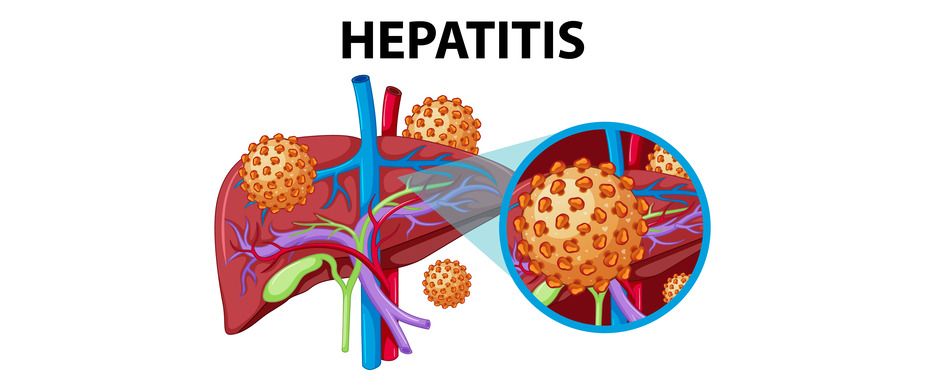Hepatitis is a potentially serious condition involving inflammation of the liver that affects millions of people worldwide. There are several ways hepatitis may be transmitted. Whether it’s through contaminated food or direct contact with infected blood, understanding how hepatitis spreads is essential for protecting yourself and those around you. Since different types of hepatitis have different transmission routes, from casual contact to more direct exposure, being informed about these risks can help you make safe choices to prevent the transmission of hepatitis. Here, we’ll explore how hepatitis is transmitted, what puts you at risk, and how you can protect yourself against hepatitis transmission.
What is Hepatitis?
Hepatitis is an inflammation of the liver. It is often caused by a viral infection, but some types of hepatitis may be caused by lifestyle choices such as drug and alcohol consumption and certain medical conditions such as other infections and autoimmune diseases. Hepatitis can be self-limiting, or it can lead to serious health issues such as liver damage, liver failure, or liver cancer.
Hepatitis may begin as a silent disease, presenting no symptoms in the first few weeks after transmission. When symptoms do occur, they may include fever, diarrhea, fatigue, nausea of loss of appetite, feeling weak, and pain on the right side of your upper belly. Symptoms of hepatitis that has progressed to a chronic disease include confusion, disorientation, or drowsiness, dark colored urine and light colored feces, itchy skin, and jaundice (yellowish skin of yellow tint to the whites of the eyes).
Types of Hepatitis and Their Transmission Routes
There are several types of viral hepatitis, including hepatitis A, B, C, D, and E. Each type varies in terms of transmission and severity.
How Hepatitis A Spreads
Hepatitis A is usually spread through ingestion of contaminated food or water. It is a fecal-oral virus, meaning it can be transmitted when someone doesn’t wash their hands properly after using the bathroom and then handles food or touches objects. It’s more common in places with inadequate sanitation or where outbreaks are ongoing. Hepatitis A doesn’t cause chronic liver disease, but it can result in severe symptoms and weeks of illness.
How Hepatitis B Spreads
Hepatitis B is transmitted through contact with infected blood, semen, or other body fluids. Common routes include unprotected sex with an infected person, sharing needles with an infected person, or from mother to baby during childbirth. It can also spread through contact with open sores or sharing personal items like razors or toothbrushes. Hepatitis B can become a chronic condition, leading to long-term liver damage, liver failure, or liver cancer.
How Hepatitis C Spreads
Hepatitis C is primarily spread through blood-to-blood contact. This most often occurs through sharing needles or other equipment to inject drugs. It can also be transmitted through improperly sterilized medical equipment or, less commonly, through sexual contact and from mother to baby during pregnancy or delivery. Chronic hepatitis C is a major cause of liver disease and liver transplants in the United States.
Less Common Forms – Hepatitis D and E Transmission
Hepatitis D occurs only in people infected with hepatitis B. It’s spread through contact with infected blood and bodily fluids, and it can make a hepatitis B infection more severe.
Hepatitis E is usually spread through contaminated water or food in areas with poor sanitation, similar to hepatitis A. Pregnant women are especially vulnerable to severe complications from hepatitis E.
High-Risk Activities That Can Spread Hepatitis
The following activities significantly increase the risk of hepatitis transmission:
- Having unprotected sex with an infected partner
- Sharing needles or syringes for drug use
- Receiving blood transfusions or organ transplants (especially in countries without rigorous screening)
- Working in health care without proper protective measures
- Living with or caring for someone with hepatitis
- Traveling to areas with poor sanitation or known hepatitis outbreaks
How to Protect Yourself from Hepatitis
There are several ways to reduce your risk of contracting hepatitis:
- Vaccination: Hepatitis A and B can be prevented through vaccines. The hepatitis B vaccine also indirectly protects against hepatitis D.
- Safe sex practices: Using protection during sexual activity reduces the risk of hepatitis B and C transmission.
- Avoid sharing personal items: Avoid sharing razors, toothbrushes, or needles.
- Hand hygiene: Wash your hands after using the bathroom and before preparing or eating food.
- Safe travel practices: Drink bottled or treated water and eat fully cooked food when traveling to countries with inadequate sanitation.
- Precautions in health care: Health care professionals should use gloves and follow infection control protocols when handling blood or bodily fluids.
When to Get Tested for Hepatitis
You should consider getting tested for hepatitis if you:
- Have engaged in unprotected sex with multiple partners
- Share needles or injection equipment
- Have liver disease or abnormal liver tests
- Were born to a mother with hepatitis B or C
- Work in health care or public safety and are exposed to blood
- Received a blood transfusion or organ transplant before the early 1990s in the U.S.
- Travel to or live in areas with high hepatitis prevalence
Testing can help detect hepatitis early, even before symptoms appear, so that treatment can begin promptly and prevent serious complications. While some types of hepatitis are acute and resolve on their own, others can become chronic and lead to severe liver complications. Safe hygiene, vaccination, and getting tested for hepatitis are important steps to protect yourself against hepatitis transmission. If you’re at risk or uncertain about your exposure, talk to a healthcare provider about hepatitis testing and prevention today.

